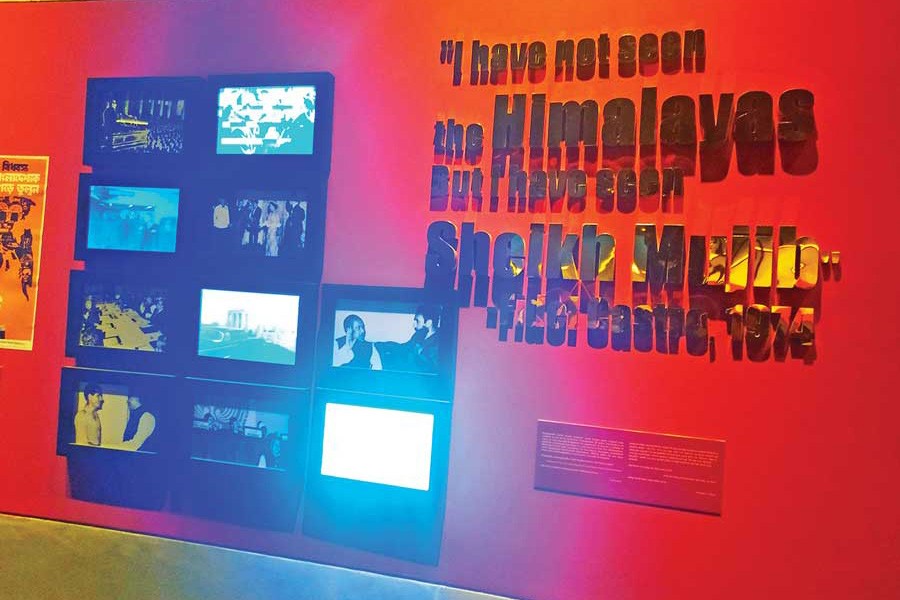A gallery, fully covered with all black backgrounds, covered the period between 1920 and 1975. Archival photographs, pencil sketches, historical videos--all depicting the journey of Bangabandhu Sheikh Mujibur Rahman. Here, one could feel the existence of this glorious character as from his birth till his run along, infinitesimal trifles have been laid bare.
It was an initiative of Centre for Research and Information (CRI), ICT Division, in collaboration with Bangladesh Shilpakala Academy and the Ministry of Cultural Affairs that arranged the Dhaka Art Summit (DAS) 2020. Marking the birth centenary of the Father of the Nation Bangabandhu Sheikh Mujibur Rahman, Ruxmini Reckvana Q Choudhury, assistant curator of Samdani Art Foundation curated this special gallery naming "Lighting the Fire of Freedom: Bangabandhu Sheikh Mujibur Rahman."
Director of Samdani Art Foundation Nadia Samdani, DAS Organizing Committee Chairman Farooq Sobhan, State Minister for Cultural Affairs KM Khalid and Director General (DG) of Shilpakala Academy Liaquat Ali inaugurated South Asia's biggest biennale fifth Dhaka Art Summit (DAS) 2020 the last month. The summit took place comprising the four floors of National Art Gallery of Shilpakala Academy. Around 500 artists from over 45 countries participated this time. Artist groups such as Artpro, Backart, Charupith, Okoliko, Hills Artist Group, Pathshala, Drik, Chobimela, Jothashilpi, Saako, Shoni Mongol Adda, Shomoy Group etc. along with other Bangladeshi artists participated at DAS2020.
DAS2020 had the theme 'Seismic movements' considering the various ruptures that have realigned and continued to shift the face of our spinning planet. Under this theme, it touched upon colonial, social, modern, independence, geologist, feminist and other movements.
An installation by artist Adrián Villar Rojas, shedding light on geology through 400-million year old ammonite and fossils, welcomed art lovers at the event. Artist Dhali Al Mamoon's artwork ‘While they came’ using tea and indigo on revolving round canvases, portrayed the time of British rule when the workers were exploited for tea and indigo plantation.
The significant artwork under the Independence Movement was Maryam Jafri's 'Independence Day 1934-1975' where the artist used 60 archival photos of countries enjoying the moments of independence. Murtaja Baseers's dinosaur and a man-women figure depicted the wartimes of Bangladeshi people. On the other hand, Bangkok artist Pratchaya Phinthong's 'Waiting for Hilsha' depicted the political conflicting story, how hilsha breeding got depreciated by Farakka Barrage issue.
Nilima Sheikh's 'Beyond Loss', the narrative scroll portrayed a very powerful message of Kashmir crisis where women are mourning, igniting the flame of cooking pot, facing the oppressive world all alone. Korean artist Sara Sejin Chang by her 'The Mother Mountain Institute' artwork explained the pain of a mother who lost her child in a fraud adoption. Chitra Ganesh, inspired from Begum Rokeya's 'Sultana's Dream' novel, gave her artworks a feminist approach.
'Roots' was curated by artist and educator Bishwajit Goswami. He engaged and organised the gallery with the knowledge of those artists who played the key role in establishing art. Here one gets the opportunity to have a glimpse of the foundation of Bangladeshi art culture and the patriarchs of Bangladeshi art history.
"Performance arts were at its best at DAS 2020," was the reaction of a visitor. He loved the message of William Forsythe's 'Fact of the matter' that spoke about an individual's experience in navigating the challenges, pressures one faces and how thinking can be activated through movements. One of the most attractive performance art was Yasmin Jahan Nupur's 'Let me get you a nice cup of tea' where any interested visitor was given the opportunity to taste the rarest collection of tea and have a 20-minutes 'cha-adda' with the artist herself about the everyday use commodity-- tea. How women can break the traditional outlooks of patriarchy was performed live by a group of women by breaking their everyday domestic use clay made vessels. Hector Zamora's 'Existence-Emitting Movements' shared space of liberation where women could turn the tide of patriarchy. Besides, there were continuous live arts by Otobong Nkanga, 'Quick Fix Remix' by Raphael Hefti, 'Together' by Korakrit Arunanondchai and Alex Gvojic.
There were a lot more short discussions by the artists themselves about 'Way of Hilsha' 'Tea Tales' 'Artist Talk' along with panel discussions about issues like 'Designing in an Era of Climate Catastrophe'.
There was a special performance for children named 'Golpata shobar' where the handmade puppets told the local history and myths surrounding a village. A printmaking workshop by Grafis Huru and Pangrok Sulap was another fascinating segment of DAS2020.
Chief Curator Diana Campbell Betacourt and Kathryn co-curated the Collective Body. In the event, Samdani Art Award was given to the talented artists of Bangladesh.
The nine-day event attracted almost 0.4 million visitors.
The writer is currently studying at Department of Mass Communication and Journalism at University of Dhaka.
She can be reached at [email protected]


